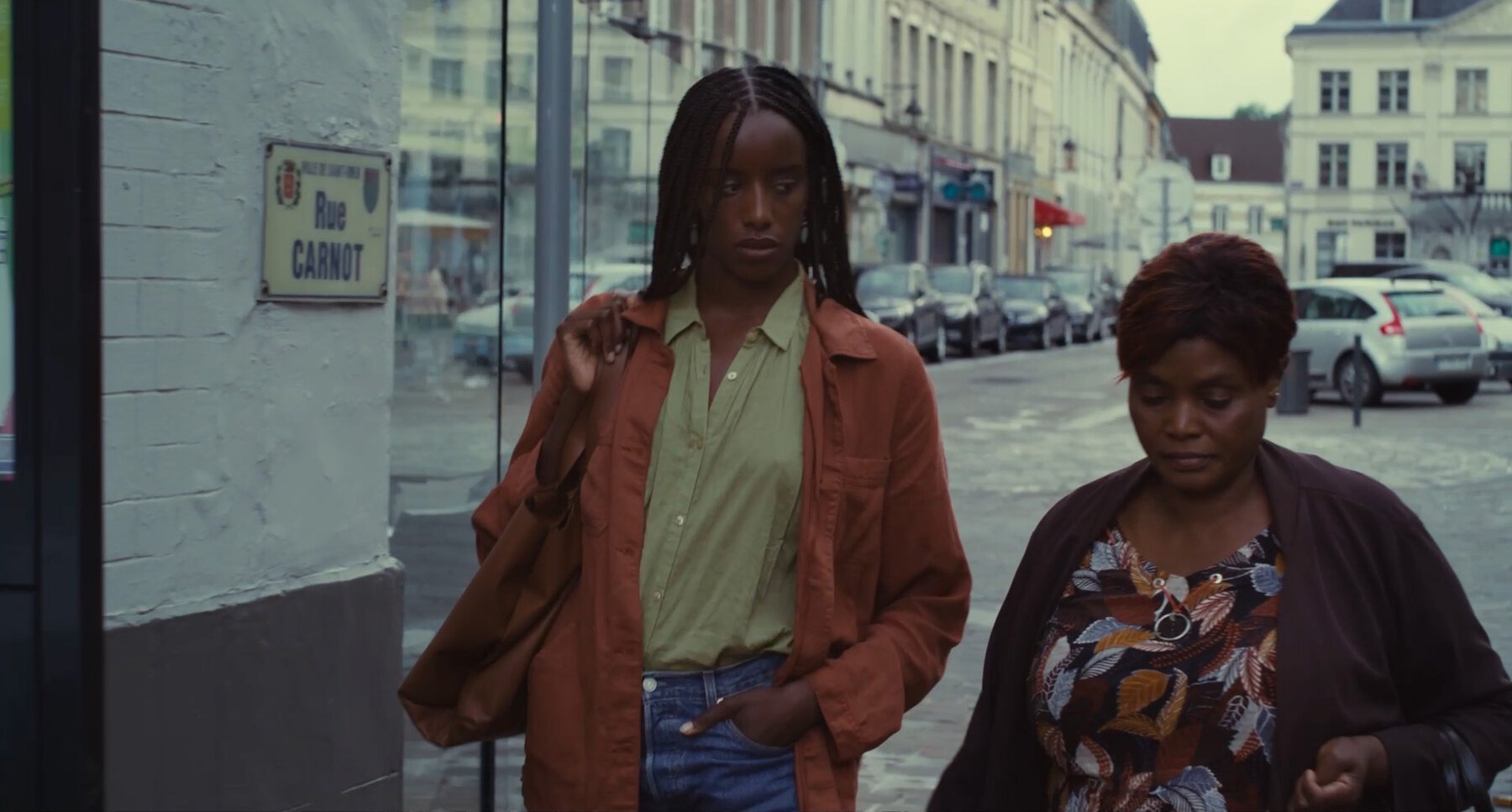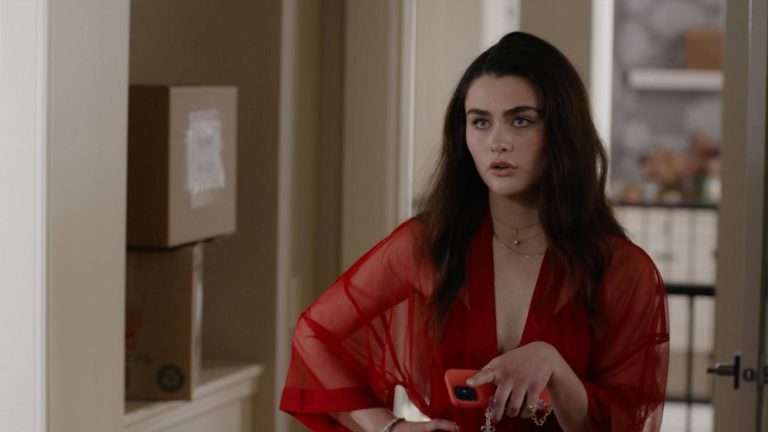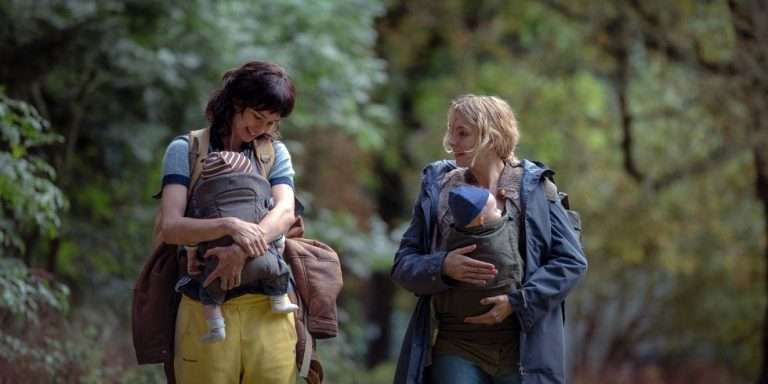Motherhood is a curious feeling. On the one hand, it is the result of a biological process leading to the natural prerogative of protection of an infant. It is expected to be instinctive, with the same appearance and passion found in every corner of humanity. The reality, however, is quite different, as motherhood is inextricably linked to personal flaws and societal circumstances. This connectivity has been the norm since time immemorial, be it in Euprides’ play Medea or Alice Diop’s Saint Omer.
Saint Omer (2022) Plot Summary & Movie Synopsis:
Documentarian Alice Diop, with her haunting yet unhurried style, bases Saint Omer on the real 2013 case of Fabienne Kabou, leaving her 15-month-old baby girl on a beach in Berck-Sur-Mer, France. Opening on that fateful night where we see a woman holding a baby in her arms and walking through a beach in the dead of night with the ocean waves masking the sound of her unhurried and yet determined footsteps, Diop unfurls that story slowly.
Diop transforms Kabou into Laurence Coly (Guslagie Malanda), a French Senegalese Immigrant who had come to France to study law. She also crafts an alter-ego in the form of Rama (Kayije Kagame), a History professor interested in making Coly’s case the centerpiece of her new project in tying this incident with the thematic resemblance of Euprides’ play Medea. To that effect, she travels to the town of Saint Omer to attend Coly’s trial, similar to how Diop had traveled to attend the trial of Kabou after reading about her in La Monde.
In Saint Omer, she chooses to recreate the setting of the court. She shoots the courtroom scenes with an unhurried air but questions, via the script, both Lawrence Coly and the audience in a manner far more direct and far less theatrical than would be expected from a normal courtroom drama, a la The Good Wife or Kramer vs. Kramer.
Coly is asked to explain herself, initially with a kind but questioning air, which slowly morphs into pressuring by the Judge, the prosecuting Attorney, and the Defense Attorney, along with the justice system’s proclivity to reconcile everything in black and white. In that regard, her personal history is questioned and almost bandied about by the spectators in the courtroom.
It is revealed that Coly immigrated to France from Senegal at the age of eight. Coly’s father provided her with the best education. But the man left her and her mother for another woman. His only prerogative was to ensure his only biological child was assimilated into French life, carrying an air of sophistication. Coly dropped out of college, where she had been studying philosophy and had embarked on a doctoral thesis on Wittgenstein.
She was in a relationship with an older man named Luc Dumontet (Xavier Maly). As the tonality of his testimony would suggest, his relationship with her was more that of a reluctant guardian than anything resembling romantic. Luc was married to another woman then, and he refuses to acknowledge her and their relationship publicly. However, he approves of her cooking the meal, even though it’s revealed that she wasn’t invited to his daughter’s wedding.
He tries to help her after impregnating her. He later admits that she is a wonderful mother to their daughter Elise, despite her volatile temper and tendency to be paranoid during fits of jealousy. The judges and the barristers insist on “an explanation” that would integrate the contradictory statements of Coly herself to understand why she would kill her child while Coly still sticks to her appeal of “not guilty.” She believes that she had been led astray by sorcery and that these events were beyond her control. She was the victim, not the perpetrator.
Rama’s presence in the film stems from her being a cracked mirror version of Coly, as the connective tissue that serves as a bracketing story and an objective perspective that makes sense from a narrative standpoint. She doesn’t appear on-screen for the majority of the courtroom scenes. Rama’s unease is explored as she becomes more and more drawn to the case. More importantly, the plaintiff chooses to see unwanted parallels between the two of them even as she tries to reconcile the events she is recording for posterity with the myth of Medea.
Saint Omer (2022) Themes Analysed:
Lack of sensationalization
Sound or a background score is an indication of artifice in the storytelling medium, especially in films. Similarly, dramatic hyperbole and an over-the-top hyperventilating showy approach add dynamism to a courtroom drama with which a pulsating or loud background score can be accompanied. The more over-the-top the genre, the better. Diop, however, forgoes all that for lack of score during the courtroom sequences.
She utilizes extremely long takes and chooses three distinctive camera positions to direct the major testimonial scenes. The inspiration for Frederick Wiseman’s documentary is evident through Diop’s filmmaking. And what the silence contributes is deeper. Because there is no sensationalization, the viewer feels immersed in the courtroom proceedings, almost as if they hear their own thoughts while working through the events on the screen.
The realistic approach is also intensified by Guslagie Malanda’s performance as Laurence Coly. Her piercing eyes emote and evoke waterfalls of emotional depth and heartbreaking confusion far more effectively than blending in flashbacks could have achieved. In fact, such methods would have broken the unease the viewer, and Rama, feel throughout the time spent in the courtroom.
Post-Colonial Subjectivity
The town of Saint Omer is shown to be almost overwhelmingly caucasian. While that observation is kept squarely in the background, it is still noticeable (especially other than the plaintiff) that Rama and the plaintiff’s mother are the only two people of color in the entire courtroom.
It is fascinating that the story’s two protagonists are two black women, born in a predominantly black environment but currently living in a French environment subject to European culture, affected by European subjectivity. It is very much evident by Rama, who, when the film opens, is lecturing on the “state of grace” of womanhood, while in the background are archival photos of European women with shaved heads, who were the collaborators of the Nazi occupation.
She then quotes Marguerite Duras’ Hiroshima Mon Amour to show how the woman, who is humiliated, distraught, and treated like a prisoner, is transformed by the author as an abject of grace. It’s fascinating because Diop uses her film to paint Laurence Coly in a way that Duras does in her text, attempting to portray her with nuance that neither the justice system nor a documentary perspective of filmmaking would allow.
Laurence Coly’s decision to possibly lie about her doctoral thesis on Wittgenstein is remarkable. Ludwig Wittgenstein is arguably one of the greatest and one of the most challenging philosophers to decode. It is galling how Mrs. Jobard, Coly’s Ph.D. professor, chooses to dismiss her choice of subject of the doctoral thesis as an act of hiding behind a shield of philosophy not resembling or grounded in her own culture.
It is especially bothersome because this chooses to diminish Coly’s intelligence. In Senegal, she was a bright and intelligent student. However, in France, she is almost invisible, the lone black face ignored amidst the sea of white, like the predominantly white town of Saint Omer.
Motherhood and Medea
The similarities between Coly and Rama go beyond their race and feelings about motherhood. Rama, like Coly, is in an interracial relationship. She also has a strained relationship with her mother and, ironically, chooses to attend the trial over spending time with her mother. It may also speak to immigrant culture, where the desire to succeed or assimilate sometimes trumps the fundamental tenets of the relationship between children and their parents.
Rama seems to have assimilated far better than Coly in that regard, teaching at Sciences-Po Public University in Paris. Her concerns about her ability to be a mother intensify as the court proceedings progress, and she begins to wonder if she will end up like her mother. Her partner assures her otherwise, recalling the scars her mother endured while navigating her life alone.
Motherhood from the perspective of Coly is different. On the one hand, she chooses to proclaim that the child is hers alone, choosing not to get out of the studio or tell her mother about the pregnancy and birth. While no concrete answers are given to her reasoning, it could be extrapolated that she was finally trying to reclaim something on her terms – her motherhood – by trying to tackle it herself, even if societal circumstances had pushed her to make that decision.
On the other hand, the myth of Medea is projected from the perspective of Coly. According to the myth, Medea betrays her maternal instincts and kills her children as an act of revenge against her unfaithful husband, Jason. However, the complexity surrounding Coly differentiates her from Medea despite the similarity between the two of them. Both of them are foreigners, forced to live in a foreign land. However, unlike Jason, Coly’s partner is a pitiful human who can be lied to or manipulated by Coly.
An interpretation of Euprides’ play of Medea suggests that Medea kills her children as an act of kindness since she worries for them and their well-being. In an interview with Girls on Tops, Diop suggested that Coly’s proclamation of placing her child on the sea is almost an offering to a higher form of motherhood, the divine personification of the ocean.
Saint Omer (2022) Movie Ending, Explained:
Monsters and Ambiguity
Saint Omer ends, perhaps far more sloppily than I would have wanted it to, with a monologue by the prosecutor, who compares Coly to a phantom, a ghost, marked by her slow disappearance from the world, leading her to commit infanticide, an incomprehensible crime. It is simple to label her a monster, as monsters can be defeated or avoided due to their grotesque visage (internal or external).
However, the prosecutor presents in her statement that Coly is mad and, in her madness, kills Elise because she thinks she has been protecting her (the Medea myth given form). She believes that Coly’s isolation, due to her lack of financial security and self-independence, leads her to hide from the world.
Her hallucinations which she experienced, were her loneliness taking form. Sorcery, which was the defense used by Coly to explain her actions, was the manifestation of her hallucinations. Thus the prosecutor instead suggests that Coly receive psychiatric help, as sentencing her would only be “condemning her to madness.”
She ends her monologue by describing how the relationship between the mother and the child in the womb leads to the transference of DNA between the two. Thus both the mother and the child become chimeric, a form of the monster within the DNA structure. It’s a fascinating inversion of the definition of monstrosity that Diop presents here.
Final Thoughts:
The movie’s flaws are twofold. First, the bracketing stories make sense from a thematic perspective. Still, their evident storytelling format via a narrative resembling a conventional movie contrasts sharply with the realistic portrayal of the courtroom drama. As a result, those sections inadvertently feel less interesting.
Secondly, there is a moment where music enters the realistic structure of the courtroom, where the mental landscape of Rama takes over the proceedings. It is a tad bit jarring when you are used to Clare Mathon’s slow editing throughout the film. However, the final shot of Saint Omer’s streets scored to Nina Simone’s “Little Girl Blue” works wonders here in tying up the thematic similarities of the two protagonists. They are both immigrants struggling with motherhood in all its different facets and mental health – like Nina Simone, too, had been.
It’s a striking example of a very confident narrative with many layers amidst direct questions posed to the audience, with some answers gleaned from it. But Saint Omer is mostly content to deal with showing Coly’s interiority and is trying to bring out the audience’s empathy, offering no secondary judgment from a filmmaking standpoint. That is one hard perspective to achieve and execute, and Diop achieves it almost flawlessly.







![Syl Johnson: Any Way The Wind Blows [2015] Review: An honest tribute to an underappreciated artist](https://79468c92.delivery.rocketcdn.me/wp-content/uploads/2022/07/Syl-Johnson-Any-Way-The-Wind-Blows-Movie-Review-1-768x512.jpg)
![Rathnan Prapancha [2021] Review: An Emotional Tale Marred By The Mediocre Narration](https://79468c92.delivery.rocketcdn.me/wp-content/uploads/2021/10/Rathnan-Prapancha-768x427.jpg)


